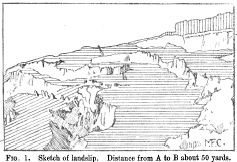No CrossRef data available.
Article contents
IV.—Note on a Landslip in the Isle of Wight
Published online by Cambridge University Press: 01 May 2009
Extract
The accompanying sketch is from a photograph taken in April, 1906, of a series of landslips just east of Chilton Chine, near Brixton, on the south coast of the Isle of Wight. The cliff, which

is composed of Brick-earth on gravel and this overlying Weald Clay, had fallen away in a series of blocks of triangular section, which were alternately base and apex uppermost; the apices in places were quite acute, and one could stride from base to base over the sharply denned apex of a clay triangle. The bases of these triangles were the grassed surface, and the apices of toughened and slickensided Brick-earth which stood up, perhaps, 4 feet beyond the grass; where the apex would naturally have been higher it was usually broken away and crumbled down. There were spaces between the blocks large enough for a horse to fall down and as much as 15 feet deep, at which depth the talus blocked the view. These spaces were overhung by the triangle that stood on its apex, so that the surface contour of my section is correct. At the time the photograph was taken the landslide was quite new, that is, small pieces of clay were falling from the overhanging faces and the fractures of grass and clay looked perfectly fresh. Possibly it had only occurred a few hours previously.
- Type
- Original Articles
- Information
- Copyright
- Copyright © Cambridge University Press 1911


